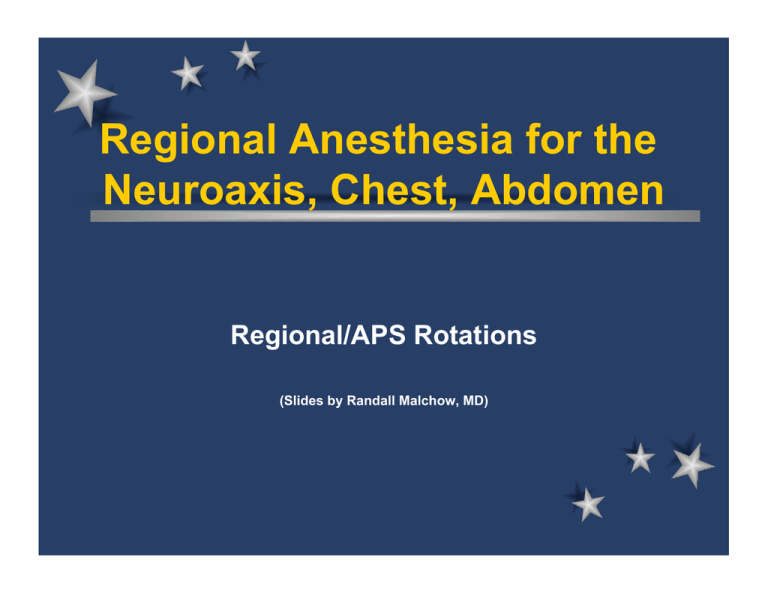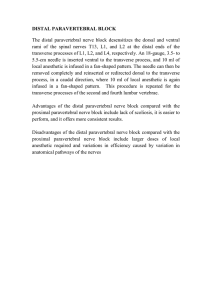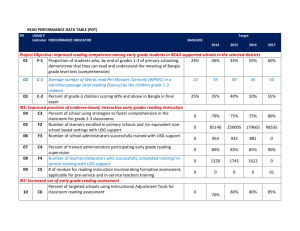Regional Anesthesia for the Neuroaxis, Chest, Abdomen Regional/APS Rotations
advertisement

Regional Anesthesia for the Neuroaxis, Chest, Abdomen Regional/APS Rotations (Slides by Randall Malchow, MD) Regional Anesthesia for Chest and Abdomen Thoracic Epidurals Intercostals Paravertebral Block Ilioinguinal, Iliohypogastric Blocks TAP/Rectus Sheath Blocks Caudals Thoracic Dermatomes note C4-T2 interface Thoracic Spine Sharply angulated sp proc Min flexion of spine (facets) Thin ligamentum flavum Thin epidural space 3-4 mm (5-6 mm in lumbar) Interspace: – T4- Upper Rib Fxs – T6- Thoracotomies – T10- Laparotomies Midline Thoracic Epidural Spinous Process at Trans Process of level below Angle 60-75 deg cephalad Paramedian Approach Esp impt at mid-thor region (Thoracotomy, MIDCABG) Lg aperture 1 cm contralat to upper T6 sp proc Touch side of sp proc, then adv needle perpendicular to lamina Adv 15-30deg med; 45 deg cephalad TEA: for Cardiac Surgery Timing: Day Before vs DOS Consider periop anticoag (eg Valves) Preinduction placement/ Test Dose T3- Sternotomy Arrow Flex-tip? Induction: Midaz 0.2mg/ kg; Panc Limit advancement, 3cm Secure catheters well Half rate during CPB Opioid: hydrophilic to maximize other dermatomes UE numbness common LE deficits concerning Duration: 72hrs; remove p CT’s out USG Lumbar Epidural (parasag) Note 3 branches of Intercostal Nerves: -posterior -lateral -anterior Intercostal Nerve Block USG InterCostal Block Paravertebral Blocks: Anatomy Spinal Process: – extend to trans process below Superior costotransverse lig – paravert space deep to ligament Paravertebral Space Actual PVB Space: very small Paravertebral Blocks Technique C7-T5 Spinal Processes 2.5cm lat to s.p. Adv 21gu x 4in stimuplex to trans proc Trans Process: 2-4 cm depth Primary Tech: T1-5 separate levels Postop Analg: T2,T5 Breast Surgery Paravertebral Block: Technique Adv inferior to trans process, <1.25cm, sup costotrans lig (addl 1cm to pleura) Paresthesia possible 5-15cc of local anes Onset: 10min Surgical anesthesia: 30-45min Add Superficial CPB Paravertebral Block: (remain in sagital plane) Too medial, CNB Too lateral, PTX PVB: Risks Failure 10% Hypotension 4% Vascular Puncture 4% Epidural Spread 1-30% (depends on vol) Spinal <1% (with laminar technique) Pneumothorax 0.2% (1:300) Paravertebral (USG Assist) Identifying Trans Processes USG Paravertebral Block (currently not recommended) USG PVBs- ? Benefit TP Lower Abdomen - Anatomy Peripheral Nerves – Iliohypogastric – Ilioinguinal – Genitofemoral – Subcostal Dermatomes – Paravertebral levels Lumbar Plexus Anatomy Genitofemoral Ilioinguinal/ Iliohypogastric LFCN Obturator Femoral IH & II: thru psoas, atop iliacus, then TA, IO, EO Other: – GF – Other Lower AbdomenNeuroanatomy IH: thru TA, then thru IO at ASIS II: parallel to IH; pierces layers more medially; then w/ cord GFN: fem branch over fem n area; gen branch w/ cord, lat scrotum USG TAP Bloc Anatomy at ASIS: Aponeurosis of Ext Obl. Internal Oblique m. Between Ilioinguinal and Iliohypogastric nerves USG TAP (lower) Rectus Sheath Block Intercostals Subcutaneous Tissue Rectus Abdominus Peritoneal Cavity Rectus Sheath Block Paravertebral Blocks: Hernias PVB’s for Hernia: – T10-L2 levels – Trans proc lie between spinal processes – Blocks sympathetics (peritoneal sac) – Wassaf: T12, L1, L2 levels only No supplementation in 80% (60% w/ field blk) 100% patient satisfaction (87% w/ field blk) USG Caudals USG Caudal- Probe Long Axis Sacrococcygeal Lig Ant Sacrum




